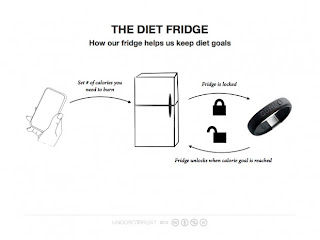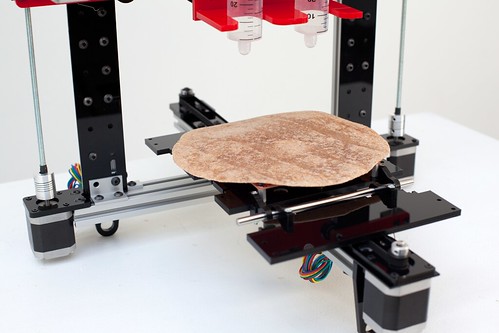Fridges seem like a good starting point for examples of Physical Computing. It is an object that we interact with each day, which has a number of data points that we currently work out in our heads (what food is in their, how much is there of each product and when does it go off). There have been a number of people and companies looking into this space. The following is a list of developments going on in this area.
Evian Water have also been getting involved in this area with the Evian Water Magnet. It lets people order Evian water from their fridges, I think this is a massive step from a high profile brand to do this. I am guessing the home delivery system in Europe is different to how it works in Australia and US, as I don't think the infrastructure would be set up to allow this to happen in these countries.
There was also a similar concept done by Dubai Pizza company 'Red Tomato Pizza'. In this video you can see how the magnet is connected via bluetooth.
Inside the fridge there has also been examples of Physical Computing Innovation. Crowd Sourced Product Innovation Company Quirky partnered with GE to create the Smart Milk Jug the 'Milkmaid'. It lets you know when your Milk is going off through measuring the PH level and temperature of the milk through sensors in the base. Read more about the technology on TechCrunch
LG Innovation arm Smart Thinq have come up with a Fridge that will help you diet. The new Health Manager will help you build a personal profile, then suggests recipes, daily and weekly meal plans, menus, and food selections based on age, gender, weight, height, and BMI.
The Digital Strategy Agency Undercurrent have also recently had a look at updating the technology in a fridge. The working prototype had scales inside to measure how much milk is left and alert you when you were running low. They also took on the dieting issue, connecting your fridge to a fitbit to measure how much you exercise and unlocking the fridge when you had reached your quota. Read the full article as it is an interesting read as they have shown how an Agency looks at the creation process of building a physical computing prototype.
Inside the fridge there has also been examples of Physical Computing Innovation. Crowd Sourced Product Innovation Company Quirky partnered with GE to create the Smart Milk Jug the 'Milkmaid'. It lets you know when your Milk is going off through measuring the PH level and temperature of the milk through sensors in the base. Read more about the technology on TechCrunch
'In MY Fridge' is a student project from the University of Applied Sciences in Schwabisch. They created a fridge with a touch screen on the front that allowed you to see what was inside the fridge and what you could make with the products. This is based on an RFID system which requires you to print off tags that you stick on the products when they go into the fridge.
Tagging items seems like the biggest barrier at the moment in the whole Physical Computing for Fridges space. However I expect that there will be some tech developments most likely around barcodes and using them as a product recognition element which should help to eliminate that issue.
Tagging items seems like the biggest barrier at the moment in the whole Physical Computing for Fridges space. However I expect that there will be some tech developments most likely around barcodes and using them as a product recognition element which should help to eliminate that issue.















